 |
by Eric Janszen
With all of this panicking into dollars we get asked a lot about deflation. "Why don't you just admit that a 1930s style depression and deflation spiral has begun and soon there will be soup lines and we'll be buying cars for $2,000 and gold will trade at $100." The reason is that we are 100% certain that dollar appreciation that we call "Ka" as part of Ka-Poom Theory will not turn into a deflation spiral. Cars are not going to cost $2,000, although there will be plenty of cheap used cars for sale, and gold will not go to $100. Here's why.
The essence of Ka-Poom Theory is that after the phony credit-based boom ends, first the dollar rises and inflation falls before dollar repatriation and government reflation policies kick in. We don't think the transition from disinflation to inflation is trade-able because we expect it to be chaotic. But we don't blame readers for trying, or wanting to.
This ain't deflation
We're not nit picking terminology here. We’ll show you what a real deflation spiral looks like: nothing whatsoever like the deflation we are seeing today that we have long forecast and call disinflation to distinguish it from the run-away deflations that occurred under the gold standard in the pre Bretton Woods era.
Deflation was common back in the days when there was something for a currency to deflate against for more than a brief period of time before the government got involved: gold. Even then, governments often abandoned the gold standard to inflate the money supply to stop deflation, especially in times of war. If you are a government and need to inflate and there's no war to fight, then make something up–like an oil "shortage" in the 1970s.
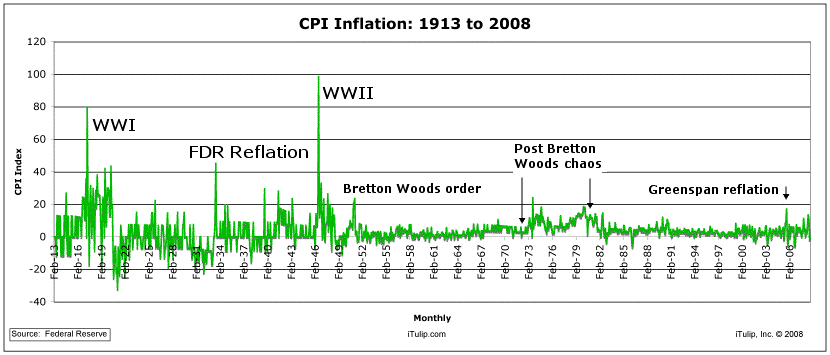
Note the early 1920s deflation reached -30% in some months and on and off for years at a time. Note also the massive inflations produced as the US government temporarily suspended gold convertibility and printed money to fund wars. Many forget that these huge swings occurred: 80% inflation during WWI and 100% inflation after WWII.
Governments can always produce inflation. Always.
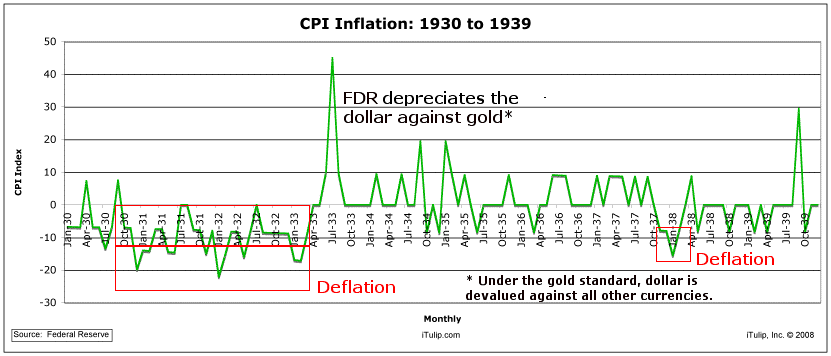
The period of deflation that occurred in the early 1930s is the one that most people think about when they hear the word "deflation." What they really mean is a deflation spiral, with the money supply imploding, credit contacting, large scale bankruptcies, rising unemployment, and falling economic output. Note that there was not a single month of inflation from 1930 to 1933. Prices went down and down and down. For years.
The 1930s deflation spiral ended abruptly in 1934. Why? FDR took the US off the gold standard and devalued the dollar 60% against gold which remained the international currency for trade transactions. As you can see from the chart this produced a 45% inflation despite the fact that the banking system was moribund as evidenced by a 50% decline in commercial credit after the failure of more than 25% of the nation's banks, and the money supply had declined 40% since 1929.
It was a dark episode in economic history and his is key–there has never been another similar period of deflation since then, in any country. Ever.
There is a reason for that: since the 1930s no country has been on a national gold standard.
Only one other government made the choice to stay on the gold standard at the time, Germany. Every other government got off the gold standard in the 1930s and inflated. Many, such as the US, finally resorted to currency depreciation when the pain got bad enough, exporting deflation. That was the impetus for Bretton Woods after the war: don't allow a repeat of competitive currency devaluations because nations in a global depression that fight each other with currencies are soon fighting each other with guns.
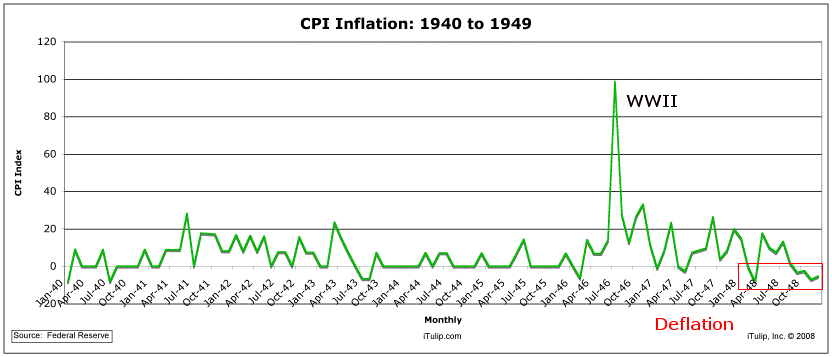
There were a very brief few months of deflation after WWII as the government attempted, Paul Volcker style, to wring inflation out of the post WWII economy. But note the deflation scale in this post-Bretton Woods period has now changed from the post-gold standard era where deflations exceeded 30% in some periods. Since then, no more 30% deflations. Rarely, for short periods when deflation has happened since Bretton Woods deflation has only once exceeded 10% in one month and has generally been limited to less than 5%.
Take-away: No gold standard, no deflation spirals. Ever again.
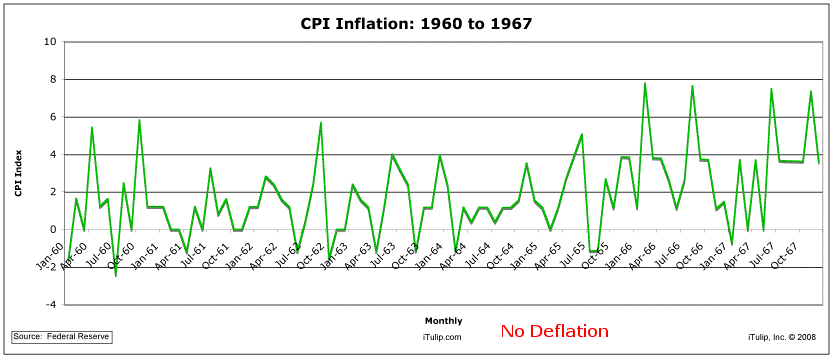
The first years of the 1960s were the golden era of monetary stability. In fact, life was so good the US government decided to ruin it by starting a war, building the military industrial complex, and launching numerous entitlement programs that we are to this day still kidding ourselves into thinking we can pay for. After running up a trade deficit that our trade partners feared we intended to pay with devalued dollars, the Europeans figured we were cheating and called our bluff by demanding payment of debts in gold. So we defaulted. US to the world: Thanks for playing!
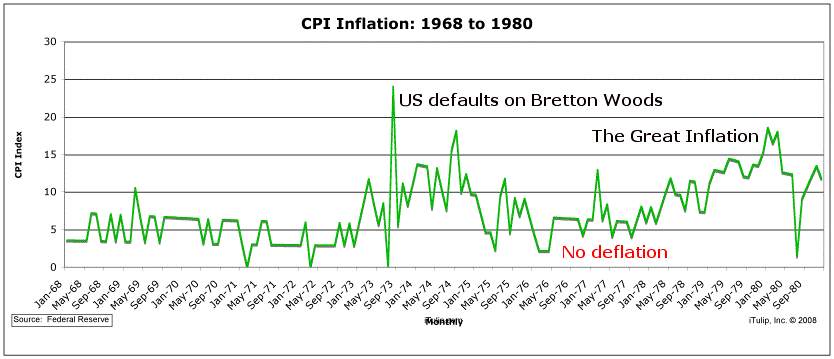
This was the ugly era of birth of the FIRE Economy. I won’t go into the details here but, clearly, deflation was not the problem. I will mention that this is when we came up with the dollar cartel to knock back OPEC and Nixon got to tell OPEC: "Thanks for playing!"
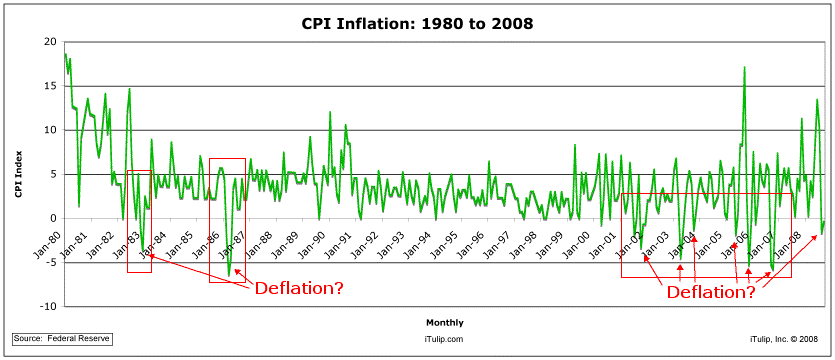
As the Paul Volcker Fed raised interest rates, the US economy experienced a short spike of deflation around -5%. Since the technology stock bubble popped in 2000, the US has had several months of deflation like that in 2002, 2004, 2006, and 2007 intermixed with short periods of inflation exceeding 15%. This inflation volatility is characteristic of periods of financial system duress and is, as you can see quite different from the latest golden era of low inflation volatility from 1991 to 2000. This was, not coincidentally, the period of the greatest bull market in stocks in history.
If you want to call today’s period of low inflation a "deflationary period" then you must also call 2002, 2004, 2006, and 2007 deflationary–actually more deflationary than today if you look at the graphs. Meanwhile oil increased from $20 to $147 over that period–not exactly a typical symptom of deflation.
Japan also has never experienced a deflation spiral. They could end their modest deflations, never exceeding -2% in a quarter off and on for more than a decade, in short order by monetizing debt but such reflation policies provide no free lunch: the trade-off for Japan would be a crashed yen–so they don't. As long as they maintain a strong current account surplus it's unnecessary. "Deflation" has been a boon to Japanese consumers. The consequence of low interest rates and cheap products while high wage rates were maintain has meant that the savings rate in Japan has over the period dropped from one of the highest to one of the lowest in the world. The US will try every trick in the book and then some before taking the drastic step of depreciating the dollar to stop a deflation spiral in the US before strong deflation expectations develop–and certainly before three years pass and the economy fails as in the 1930s–but ultimately can if necessary crash the dollar to do so.
The critical take-away is that we are indeed experiencing short term deflation. We call it disinflation here in the context of Ka-Poom Theory to keep readers from confusing the process with the start of a deflation spiral–which cannot happen under a floating exchange rate, fiat money system. The only way it could is if governments around the world all got together and decided to crash the global economy. That strikes us as unlikely. More likely one or more will move to reflate using currency devaluation.
If the Fed so desired the US could have 100% inflation by the middle of 2009 as the US did in 1946. All that is needed is for Congress to borrow a few more trillion into existence to fund old and new liabilities and have the Fed print it because our government cannot borrow the money from overseas or raise taxes, or devalue the dollar, or both.
It’s just that simple. Wish it wasn’t so. Trust your government not to do it?
Neither do we.
If not deflation, then what? Stagflation?
Keep an eye on producer price index, commercial lending rates, and wage rates. These tell you how much your local grocery stores, restaurants, gasoline stations, and other businesses have to pay–their input costs–as the recession drags on. As recession deepens, businesses have to cut prices to their customers to meet lower demand. If input costs don't fall quickly, many of these companies will either go out of business or be acquired by stronger rivals that have more cash or access to credit. If this goes on for years, as we expect it to, instead of a short drive to the local Home Depot it's a long drive, instead of 10 restaurants to choose from in the area there are five, instead of four grocery stores to visit there are two, instead of four daily flights to your favorite destination from the nearest airport there is one. The plane is crowded. You are packed in like a sardine. The fare is expensive.
Inflation comes not only from surfeit of money relative to goods and services but also a shortage of goods and services relative to the supply of money.
In a couple of years when you get to the one remaining Home Depot in your area that has not closed you will find that it's crowed. As most of the goods that Home Depot sells are imported, and the dollar continued to decline after the current short term panic into dollars ends–and the impact of net negative capital flows exerts its natural downward pricing on the dollar–the wholesale prices Home Depot pays will not decline much if at all. The government will welcome the devalued dollar, as it has since 2002, because the inflationary impact helps counter the deflationary impact of debt deflation and helps the US export position. Wage rates will not rise because recession will have caused higher unemployment and reduced wage earner's pricing power. However, at that point there will be few stores (boom market in plywood to cover plate glass windows?) and two or three times as many consumers vying for the same goods, and the cost of imports is up because the dollar had depreciated further; prices may actually rise.
In response, consumers will buy fewer things and will substitute lower quality products for higher quality products, hamburger for steak. The golden age of the American consumer ends.
Let's say you are an American visiting an indebted country years ago that has lost its ability to extend its purchasing power via foreign borrowing because that is the situation that the US faces today. For example, Mexico in the early 1980s. What do you see? You spend your strong dollars so experience prices there as cheap. You see crowded stores and low prices–crowded because the equilibrium price between the cost of goods that stores pay and prices that customers can afford creates only enough demand to support a small number of stores for the local population. But the people who live there experience the same stores as crowded but with high prices. Why? Because while the new equilibrium price for goods is now the same as before or maybe higher, but the purchasing power of consumers has fallen due to lack of access to credit and falling incomes.
That is our future in the US once the spike in the value of the dollar ends and the dollar continues its decline through this recession. This picture may, however, be distorted by government intervention to support the housing and credit markets to slow debt deflation. Government spending may further weaken the US dollar. Then there is the possibility that immigration and trade policy will change to address wage deflation by lowering competition for jobs via restrictions on outsourcing and immigration.
For my take on where the financial crisis and economic recession are going see Global Finance Disneyland Demolition ($ubscription). The fantasy is over.
iTulip Select: The Investment Thesis for the Next Cycle™
__________________________________________________
To receive the iTulip Newsletter or iTulip Alerts, Join our FREE Email Mailing List
Copyright © iTulip, Inc. 1998 - 2007 All Rights Reserved
All information provided "as is" for informational purposes only, not intended for trading purposes or advice. Nothing appearing on this website should be considered a recommendation to buy or to sell any security or related financial instrument. iTulip, Inc. is not liable for any informational errors, incompleteness, or delays, or for any actions taken in reliance on information contained herein. Full Disclaimer

 .
.

Comment